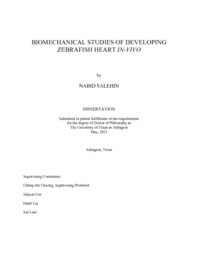| dc.description.abstract | The heart is an electrically controlled mechanical pump that provides the cardiac output required by the body to function properly and flexibly adapts to changing demand and working conditions. In vertebrate embryos, the heart is the first organ that starts functioning and the function is initiated well before structural organogenesis is complete, with its early mechanical function affecting its own development. During development, the heart transforms from a valveless linear peristaltic tube into a multi-chambered pulsatile pump with blood flow regulating valves while continuing to serve the metabolic needs of the embryo. The zebrafish has emerged as a popular model system for in vivo studies of developmental biology due to its unique features including high fecundity, external fertilization, rapid organ development and optical transparency. In this study, we analyzed the changing mechanical function of the embryonic zebrafish heart in-vivo, both overall and regional, through the developmental period of 3 to 5-days post fertilization (dpf).
For Aim 1, we assessed the changing pressure-volume relationships of the developing ventricle of zebrafish in-vivo. We measured intra-ventricular pressure using servo null method and reconstructed ventricular volume using selective plane illumination microscopy (SPIM), a light sheet fluorescence microscopy technique. Pressure volume (P-V) loops were constructed by synchronizing measured intra-ventricular pressure and ventricular volume that facilitated hemodynamic analysis. Results indicated significant increases in peak systolic pressure, stroke volume, cardiac output, stroke work, power generation, and a decrease in the total peripheral resistance of the developing heart from 3 to 4 and 5 dpf.
In Aim 2, we examined the regional function of the ventricles from zebrafish embryos at 3, 4, 5 dpf. We developed a method that characterized the regional deformation of the ventricular myocardium by tracking the moving 3D coordinates of the fluorescing cardiomyocytes through cardiac cycles. Our results did not show statistically significant differences in regional area ratios. The ventricular wall myocardium was found to have higher compliance at 3 dpf than 4 and 5 dpf groups. On the other hand, the ventricular myocardium was found to have higher systolic performance index at 4, 5 dpf than at 3 dpf. The developing myocardium becomes stiffer from 3 to 5 dpf and generates higher ventricular pressure at faster rates during ejection. Resolving the deformation into principal stretches lambda1 and lambda2, acting along longitudinal and latitudinal directions respectively, differences were noted. From 4 and 5 dpf groups, end diastolic lambda2 was larger than lambda1 in all three regions and differences between lambda2 and lambda1 also existed at end systolic state. At 5 dpf, significant regional difference was detected in both lambda2 and lambda1. Our results suggest that along with the developmental changes in morphology, vasculature and maturation of valves, the embryos at 4, 5 dpf underwent anisotropic deformation favoring latitudinal direction.
Aim 3 is an extension from Aim 2 wherein we further divided the ventricular surface into 8 sub-regions to systematically map out the differences in deformation characteristics along circumferences at different axial positions and the differences in three dpf groups. Results revealed not only the regional differences but also the tethering effects due to the presence of AV valve and its opening closure through a cardiac cycle when regulating blood flow.
Collectively, results from three aims revealed insights in our understanding of the increasing operational efficiency of the early-stage zebrafish heart when undergoing rapid growth. The development of the heart occurs in time with concurrent changes in myocardium growth, in valve development, in chamber morphology, and in the improving efficiency of the physiological pumping function supplying blood to feed the increasing complexity of the vascular network of the organism. | |


